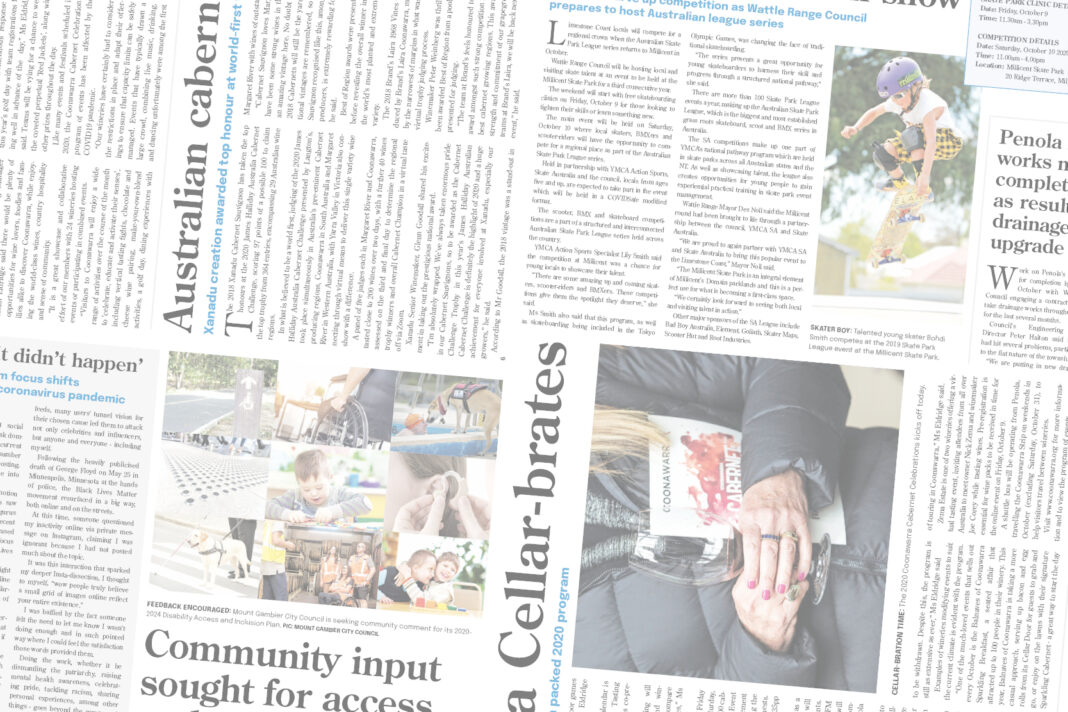What is important to users of Lake Bonney and Lake George has been highlighted in a report recently released by the Department for Environment and Water.
Community discussions from a series of face-to-face and online workshops has been prepared in a report as part of the Department’s South East Coastal Lakes Project.
Attendees of the workshop held in Millicent in June have received a summary of the information collected.
The South East coastal lakes of Lake Bonney SE at Millicent and Lake George at Beachport were popular choice of discussion.
Other lakes identified for discussion included Lake Eliza, Lake St Clair, Lake Hawdon North and Mullins Swamp.
The 11-page report summarises the feedback gathered from a range of individual and interactive small group activities.
However, it was noted that not all workshop attendees participated in all of the engagement activities or provided responses to all questions.
The round table workshop formed the first stage of a three-phase project.
The intention of the workshop was to identify opportunities to manage the region’s coastal lakes differently.
More than 70 locals took the opportunity to talk about how they use and value the South East coastal lakes.
The department undertook the engagement and planning process, inviting the public to discuss and put forward ideas for future management of the various coastal lakes.
Gathering information included targeted conversations and insights.
The key objectives of phase one of the engagement has been to better understand how the lakes are currently used, understand how the lakes are valued, identify opportunities to better manage the lakes to maintain their unique and iconic natural features while providing access for their ongoing enjoyment.
To help understand the range of interests represented, participants were asked to identify themselves in relation to how they currently use the coastal lakes.
Participants could identify multiple ‘user types’ with the most commonly identified lake ‘user type’ was hunter, followed by fisher and camper. The next most commonly selected user types were farmer and four-wheel drive enthusiast.
According to the report, this activity was not intended to be statistically valid but provide an indication of interests in the room.
Referred to as “a backyard for the locals of the South East”, Lake George was commonly identified as a popular attraction for activities including fishing, hunting, camping, windsurfing, four-wheel driving, birdwatching and meeting people.
Several participants identified they would like to both Lake George and Lake Bonney left as Crown Land.
The majority of comments for Lake George related to the management of the lake remain by the Lake George Management Committee” with more funding from the National Park and Wildlife Service.
While management of Lake Bonney be overseen by a similar group to the Lake George Management Committee.
Aspects that were considered important about Lake Bonney included its history, tradition and heritage which participants wanted future generations to be able to enjoy.
Many comments related to ensuring “all activities are maintained and enhanced” with public access, fishing, hunting, windsurfing, camping, dog access and sightseeing to remain “for the enjoyment of all” to provide a “continuation of the freedoms we have now”.
There were numerous comments relating to improving the water flows of Lake George, both through “periodic ingress of salt water” and “redirecting the water from Mount Hope Drain and Reedy Creek Drain to Lake George”.
This included addressing the “ever growing size of the reverse delta at the mouth of Drain M along with the silting up of Little Lake”.
Participants suggested that “some more money and time should be spent to clean it up” and improve the water quality and remove the logs for both environmental and recreational benefits.
The feedback gathered has been collated for consideration by Climate, Environment and Water Minster Susan Close.
A South East Coastal Lakes Project Team spokesperson said the workshop summary would be used along with summaries of other engagement activities including the online feedback.
“This will be used to inform the development of an engagement summary report that describes the issues and opportunities raised by all stakeholders engaged during this phase of work,” the spokesperson said.
“Information and stakeholder input from phase one is being collected and collated for the Minister’s consideration ahead of phase two.
“Phase two will include public consultation on a proposal outlining management options for the coastal lakes.
“Details on this consultation phase will be made at a later date.”




